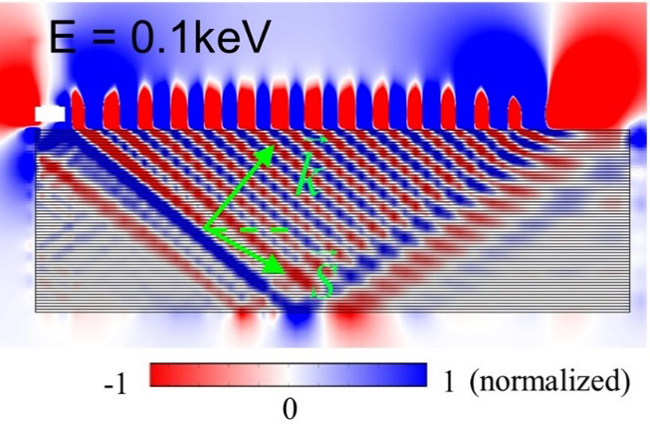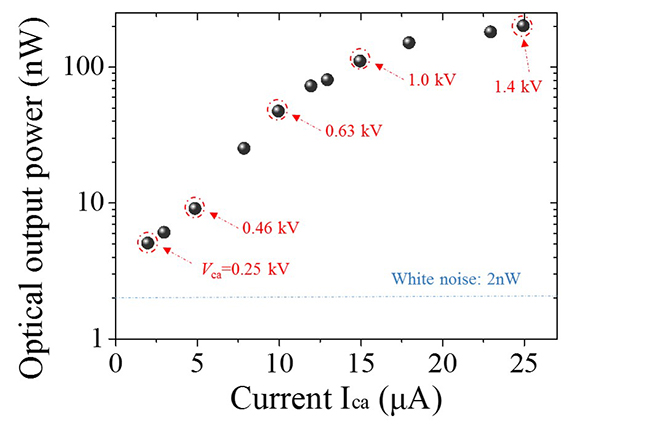Breakthrough by Fang LIU and his colleges from Tsinghua University
Uniformly moving charged particle with rather low velocity could radiate electromagnetic waves
On April 11th, associate Prof. Fang LIU and Prof. Yidong HUANG, Department of Electronic Engineering, Tsinghua University, and their colleges, published the paper titled “Integrated Cherenkov Radiation Emitter Eliminating the Electron Velocity Threshold” in Nature Photonics. This work provides a way to realize threshold-less Cherenkov Radiation (CR), opening up the possibility of exploring high performance integrated free-electron light source and offering a platform to study the interaction of flying electrons with nanostructures on chip.
CR is the electromagnetic radiation emitted by a moving charge passing through a dielectric medium with a uniform velocity above a certain threshold. In the early 20th century, the discovery and explanation of CR overturned the knowledge that no material body can move at a velocity exceeding light speed in a media and a uniformly moving charged particle cannot radiate electromagnetic waves. Pavel A. Cherenkov and other two scientists were awarded the Nobel Prize in Physics in 1958 for their outstanding work in this area. After its discovery, CR has played a key role in discovering some fundamental particles and physical phenomena, such as anti-proton, J-particle, and neutrino oscillations.
To generate CR, the velocity of a charge should be higher than the phase velocity of light in the medium. In an initial experiment, Cherenkov generated the radiation in water with electron velocity of 0.7c (corresponding to energy of about 300 thousands eV), where c is the light speed in vacuum. Although various approaches were adopted, high-energy electrons (tens of thousands of eV) were still required to generate CR experimentally in the visible/infrared light region. In terms of application, CR is one of the approaches to realizing free-electron light source, which is rather important in the field of fundamental physics, military, biology, information science, and so on. Similar to other methods, the electrons should be accelerated to an ultra-high velocity, which requires large volume (several to thousands of meters) equipment.Decreasing the threshold of electron energy for CR remained a basic scientific problem remaining for tens of years.

(a) Schematic of integrated CR emitter,(b) Scanning electron microscope images of CR emitter. (Left) Planar Mo electron emitter, (Middle) Hyperbolic metamaterial, (Right) Periodic plasmonic Au nano-slits.

Numerical simulation of CR with electron energy of 0.1keV.

Measured optical output of the integrated CR emitter.
Prof. Huang’s group began the research on micro- & nano- optoelectronic devices since 2004 and accumulated rich experiences on fabrication and measurement of optoelectronic devices. Group members, Fang LIU, Long XIAO (PhD candidate), and other colleges made an important discovery in theory when they studied the CR in multilayer hyperbolic metamaterial (HMM) in theory that the CR could be excited in HMM no matter how slow the electrons moves (namely threshold-less CR).
To verify this theoretical result, in the next two years they overcame lots of difficulties in experiment, such as the fabrication of planar electron emitter on chip, the multilayer HMM with thickness of ten nanometers for each layer, the plasmonic nano-slits, and the measurement of CR in HMM. Finally, they succeeded in observing the threshold-less CR by extracting the free electrons from nano-scale Mo tip and having the electrons fly a distance of 200 micron above parallel to the surface of HMM with height of only 40nm. The wavelength of CR ranges from 500~900nm and the electron energy is only 250~1400eV, which is two to three orders of magnitude lower than previous reports. The measured output light power reaches 200nW, which is two orders of magnitude higher than free electron light source by using other nanostructures.
This work has solved the problem of generating CR with rather low electron energy and realized the first integrated free-electron light source on chip. Eliminating the threshold of charge velocity and high radiation efficiency opens the possibilities of wideband radiation sources from UV light to THz by designing proper HMM structures. Moreover, such an integrated CR emitter brings CR from the field of high-energy physics to integrated devices. It also provides a platform for studying the interaction between the flying electrons and various kinds of artificial nanostructures on chip, and more integrated vacuum optoelectronic devices can be expected in future.
Associate Prof. Fang LIU is the first author and corresponding author, PhD student Long XIAO is the co-first author, and Prof. Yidong HUANG is the corresponding author. This work was supported by the National Basic Research Programs of China (973 Program) under Contracts No. 2013CBA01704, the National Natural Science Foundation of China (NSFC-61575104 and 61621064).
Published in Nature Photonics on April 11th (Impact factor 31)
http://www.nature.com/nphoton/journal/vaop/ncurrent/full/nphoton.2017.45.htm
(Edited by Huashan Li)

